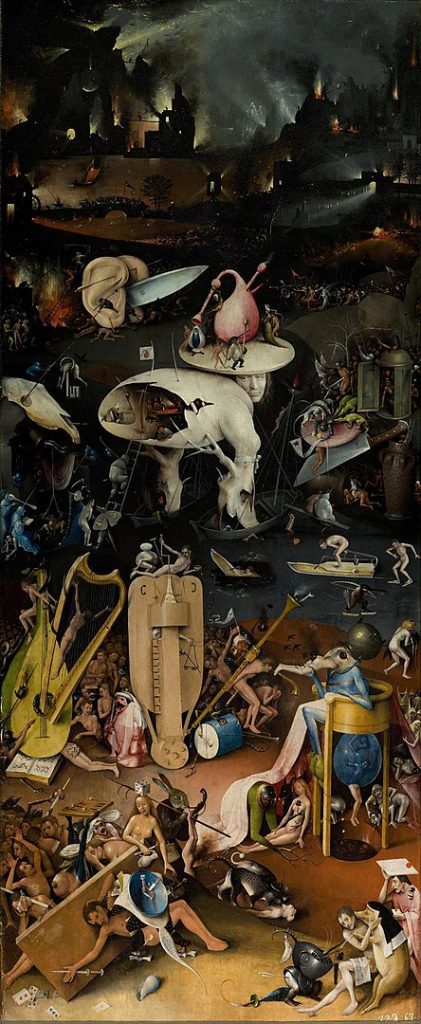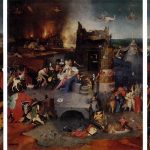
Hieronymus Bosch, born Jheronimus van Aken around 1450 in what is now the Netherlands, remains one of the most enigmatic artists of the Northern Renaissance. His life is shrouded in mystery, much like his artwork. Although widely recognized, little is known about Bosch’s personal life or the motivations behind his surreal and often disturbing imagery. He lived during a time of religious upheaval, which may have influenced his work, but historians can only speculate.
Bosch’s life in ‘s-Hertogenbosch, a city in the Duchy of Brabant, offered him a view of the world that was both deeply religious and tumultuous. His father, grandfather, and uncles were all painters, suggesting that art was a family trade. However, Bosch’s style diverged sharply from the traditional religious iconography of his time. His works were not simple depictions of biblical scenes but rather complex allegories filled with bizarre creatures, nightmarish landscapes, and unsettling symbolism.
Despite his fame during his lifetime, Bosch left behind no personal writings or detailed records. This absence of documentation has only added to the allure and mystery surrounding him. Scholars continue to debate the meaning of his works, but the true intentions behind his nightmarish visions remain elusive.
The Surreal Imagery of Bosch’s Masterpieces
Bosch’s paintings are a kaleidoscope of the grotesque and the fantastical, filled with scenes that seem to leap straight out of a dream—or more accurately, a nightmare. His most famous work, The Garden of Earthly Delights, is a triptych that challenges the viewer’s perception of reality and morality. The left panel depicts the Garden of Eden, the center panel shows a world steeped in sinful pleasures, and the right panel portrays a terrifying vision of Hell.
The imagery in these panels is bewildering, even by modern standards. The Garden of Eden is populated not only by Adam, Eve, and various animals, but also by strange hybrid creatures that defy classification. The central panel, often interpreted as depicting humanity’s descent into sin, is filled with nude figures engaged in various pleasures, surrounded by oversized fruit and birds, and watched over by eerie, otherworldly beings. Finally, the Hell panel features horrific scenes of torment, with demonic figures punishing the damned in creatively grotesque ways.
Bosch’s imagination seemed to know no bounds. His depictions of Hell are particularly disturbing, filled with imagery that seems to draw from the darkest recesses of the human psyche. Scholars have suggested that Bosch was influenced by medieval visions of Hell and damnation, but his works take these ideas to extremes that are uniquely his own. The imagery in Bosch’s paintings is so vivid and bizarre that it continues to captivate and confound viewers even after more than 500 years.
Symbolism in Bosch’s Work: A Puzzle for Historians
The surreal imagery in Bosch’s paintings is not merely decorative; it is laden with symbolism. However, deciphering this symbolism is no easy task. Bosch lived in a world where religion permeated every aspect of life, and his works reflect this deeply spiritual worldview. Yet, his approach to religious themes was anything but conventional.
Many of the symbols in Bosch’s paintings appear to have religious connotations. For example, the oversized fruit in The Garden of Earthly Delights is often interpreted as a symbol of the fleeting pleasures of the flesh. The bizarre creatures that populate his works, half-human and half-animal, could be seen as representations of sin and the corruptibility of the soul. However, these interpretations are just that—interpretations. Bosch left no guide to his symbols, and modern viewers can only guess at their meanings.
One particularly intriguing aspect of Bosch’s symbolism is its possible connection to medieval alchemy and mysticism. Some scholars have suggested that Bosch’s works contain hidden references to alchemical processes, which were seen as symbolic of spiritual transformation. The idea of a secret, esoteric meaning in Bosch’s paintings adds another layer of mystery to his work, making it even more compelling.
But despite the many theories, no one has yet unlocked the full meaning of Bosch’s symbolism. His paintings are like visual puzzles, inviting viewers to piece together their meanings while resisting any definitive interpretation. This ambiguity is part of what makes Bosch’s work so fascinating and enduring.
The Influence of Medieval Thought on Bosch
To understand Bosch, one must consider the context in which he lived and worked. The late Middle Ages was a time of intense religious devotion, but also of fear—fear of sin, fear of the Devil, and fear of eternal damnation. These fears are reflected in the art of the time, and Bosch’s work is no exception. However, Bosch did not simply echo the concerns of his contemporaries; he amplified them, creating visions of Hell and damnation that are more nightmarish than anything else produced during that period.
Medieval thought was deeply influenced by the teachings of the Catholic Church, which emphasized the dangers of sin and the importance of repentance. The Church also promoted the idea of the world as a battleground between good and evil, a theme that is evident in Bosch’s work. His paintings often depict the struggle between virtue and vice, with humans caught in the middle.
But Bosch’s work goes beyond mere religious instruction. His visions of Hell are so detailed and imaginative that they seem to transcend the traditional boundaries of medieval art. Some scholars have suggested that Bosch was influenced by the apocalyptic literature of his time, which often featured vivid descriptions of the torments of the damned. Others have pointed to the influence of medieval bestiaries, which cataloged strange and fantastical creatures.
Regardless of his influences, Bosch’s work stands out for its originality and its ability to evoke a visceral response in viewers. His paintings tap into the deep-seated fears and anxieties of the medieval mind, but they do so in a way that is entirely unique. Bosch’s work is a window into the medieval soul, but it is a window that offers a view unlike any other.
Modern Interpretations: Psychosexual Analysis and Beyond
In the 20th century, Bosch’s work was reinterpreted through the lens of psychoanalysis, particularly the theories of Sigmund Freud. Some art historians have suggested that Bosch’s paintings, with their strange creatures and bizarre scenarios, represent the workings of the unconscious mind. The idea that Bosch’s work reflects hidden desires and anxieties has led to some fascinating, if controversial, interpretations.
One of the most well-known psychoanalytic interpretations of Bosch’s work is the idea that his paintings express repressed sexual desires. The abundance of naked figures and erotic imagery in works like The Garden of Earthly Delights has led some scholars to view Bosch’s paintings as a visual exploration of human sexuality. This interpretation suggests that Bosch was not only concerned with the moral implications of sin but also with the psychological aspects of desire and repression.
However, psychoanalytic interpretations of Bosch’s work are not universally accepted. Some scholars argue that these interpretations impose a modern perspective on a medieval artist, distorting the original meaning of his work. They suggest that Bosch’s imagery should be understood within the context of his time, rather than through the lens of modern psychology.
Despite the controversy, psychoanalytic interpretations of Bosch’s work have contributed to a deeper understanding of his art. They have opened up new ways of thinking about Bosch’s imagery, suggesting that his paintings are not just religious allegories but also explorations of the human psyche. This perspective has added to the complexity and richness of Bosch’s work, making it even more intriguing to modern audiences.
The Enduring Appeal of Bosch’s Nightmarish Visions
More than five centuries after his death, Bosch’s work continues to captivate audiences around the world. His paintings are not only visually stunning but also deeply thought-provoking, inviting viewers to explore their own fears and desires. Bosch’s ability to tap into the universal aspects of the human experience is one of the reasons his work has endured.
Bosch’s influence can be seen in a wide range of artistic movements, from the Surrealists of the early 20th century to contemporary artists exploring the boundaries of reality and imagination. His work has inspired filmmakers, writers, and other creatives who are drawn to his dark, dreamlike visions.
One of the reasons for Bosch’s enduring appeal is the sense of mystery that surrounds his work. Despite centuries of analysis, his paintings continue to defy easy interpretation. This ambiguity allows viewers to bring their own experiences and perspectives to his work, making each encounter with a Bosch painting a unique experience.
Bosch’s work also resonates with modern audiences because of its timeless themes. The struggle between good and evil, the dangers of temptation, and the fear of the unknown are concerns that continue to resonate today. Bosch’s ability to address these universal themes in such a distinctive and imaginative way ensures that his work will continue to be relevant for generations to come.
Bosch’s Influence on Contemporary Art and Culture
Hieronymus Bosch’s influence extends far beyond the art world. His work has left a lasting mark on popular culture, inspiring everything from movies and video games to fashion and music. Bosch’s ability to create vivid, otherworldly landscapes filled with strange creatures and surreal imagery has made him a natural source of inspiration for artists and creators across various mediums.
One of the most notable examples of Bosch’s influence in contemporary culture is in the world of cinema. Filmmakers like Guillermo del Toro and David Lynch have drawn on Bosch’s imagery to create their own nightmarish visions. Del Toro, in particular, has cited Bosch as a major influence on his work, particularly in films like Pan’s Labyrinth and Crimson Peak. These films, like Bosch’s paintings, explore the boundaries between reality and fantasy, blending the beautiful with the grotesque.
Bosch’s influence can also be seen in the world of video games, where his surreal landscapes and bizarre creatures have inspired game designers. The Dark Souls series, for example, features environments and monsters that echo Bosch’s nightmarish visions. These games, like Bosch’s work, challenge players to navigate a world where danger lurks around every corner.
In the fashion world, Bosch’s influence is evident in designs that incorporate elements of his work, from the intricate patterns of his landscapes to the strange creatures that populate his paintings. Designers like Alexander McQueen and Vivienne Westwood have drawn on Bosch’s imagery to create collections that are both beautiful and unsettling.
Even in music, Bosch’s work has found a place. Bands like Dead Can Dance and Current 93 have drawn on Bosch’s imagery and themes to create music that is haunting and atmospheric. Bosch’s work, with its dark, dreamlike quality, lends itself well to music that explores similar themes.
The Mystery That Remains
Despite all the analysis and interpretation, Hieronymus Bosch remains an enigma. His works continue to baffle and intrigue, refusing to give up their secrets. Perhaps that is part of their enduring appeal. Bosch invites us into his world, but he does not offer easy answers. Instead, he presents us with puzzles—visual riddles that challenge our perceptions and provoke our imaginations.
The mystery of Bosch is not just in his imagery, but in the man himself. Who was Hieronymus Bosch? What drove him to create such strange and unsettling visions? These are questions that may never be answered. But perhaps that is as it should be. The mystery is part of what makes Bosch’s work so compelling. It invites us to look deeper, to explore not just the surface of his paintings, but the complex and often disturbing world that lies beneath.
Bosch’s work is a testament to the power of art to transcend time and place, to speak to the deepest parts of the human experience. His paintings are as relevant today as they were in the 15th century, continuing to inspire, provoke, and challenge us. Bosch may remain a mystery, but his work is a mystery that continues to fascinate, and that, perhaps, is the greatest legacy an artist can leave.
Conclusion
Hieronymus Bosch’s work is a journey into the unknown. It is an exploration of the darkest corners of the human mind, a reflection of the fears and anxieties that have haunted humanity for centuries. Bosch’s paintings are not just works of art; they are windows into a world that is both familiar and alien, a world that continues to captivate and intrigue.
Bosch’s legacy is one of mystery and wonder. His work challenges us to look beyond the surface, to delve into the deeper meanings that lie hidden within his surreal imagery. In doing so, Bosch invites us to confront our own fears and desires, to explore the boundaries of reality and imagination. And in that exploration, we find not just the mystery of Bosch, but the mystery of ourselves.
As art historian Erwin Panofsky once said, “Bosch’s world is one of which we never tire, because it is always full of life.” Indeed, Bosch’s work is a testament to the enduring power of art to move, to challenge, and to inspire. The mystery of Bosch may never be fully solved, but it is a mystery that will continue to captivate us for generations to come.




